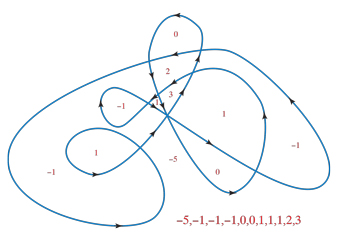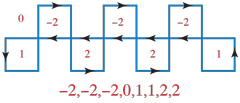This is something of a followup to an earlier question Can any sequence of consecutive integers be realized as winding numbers?, whose answer is Yes.
Now I would like to define a local winding number for a plane curve as follows. For any region $R$ delimited by arcs of a plane curve $C$, define the local winding number as the number of counterclockwise arcs bounding $R$ minus the number of clockwise arcs bounding $R$. It might be easiest to assume that two arcs that meet cross there, so tangencies are excluded.

As @ZachTeitler observed in a preliminary (now deleted) version of the question, "the sum of all the local winding numbers [must be] $0$, because each arc counts $+1$ on one side and $-1$ on the other." Indeed in the example above, the sum is zero.
My question is:
Q. Are there any other constraints to the sequence of local winding numbers defined by a plane curve?
I've explored a bit without seeing clear patterns, except for classes of regimented curves, e.g.:

